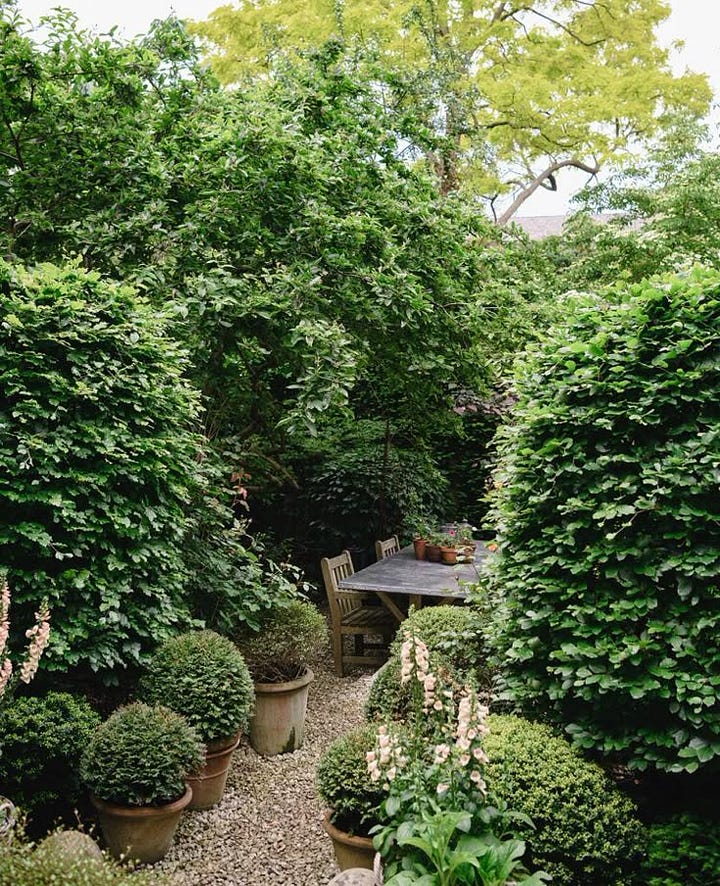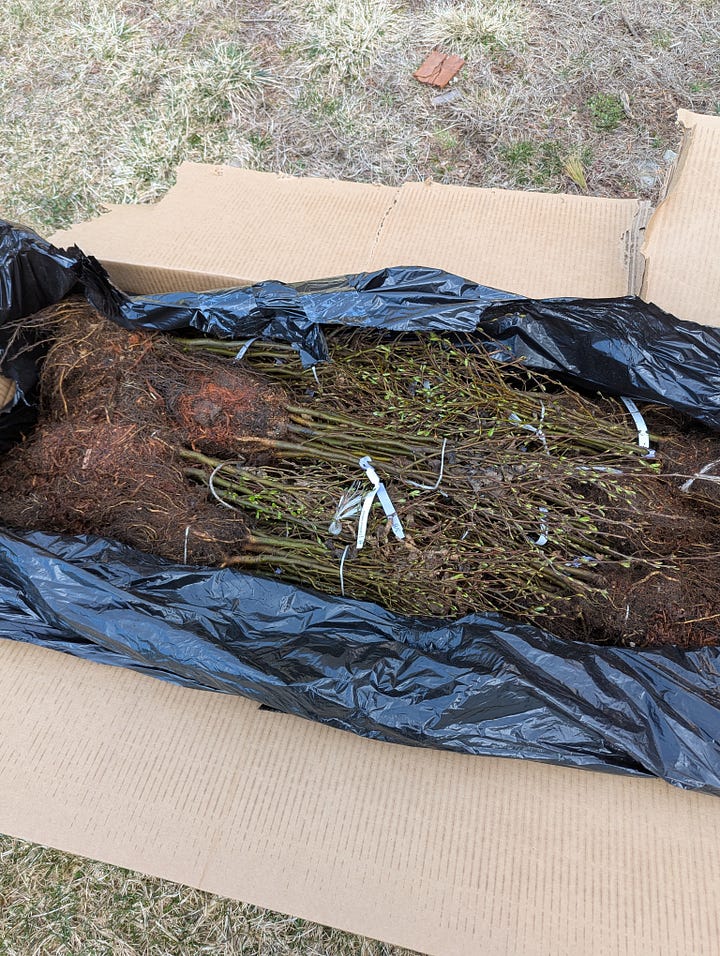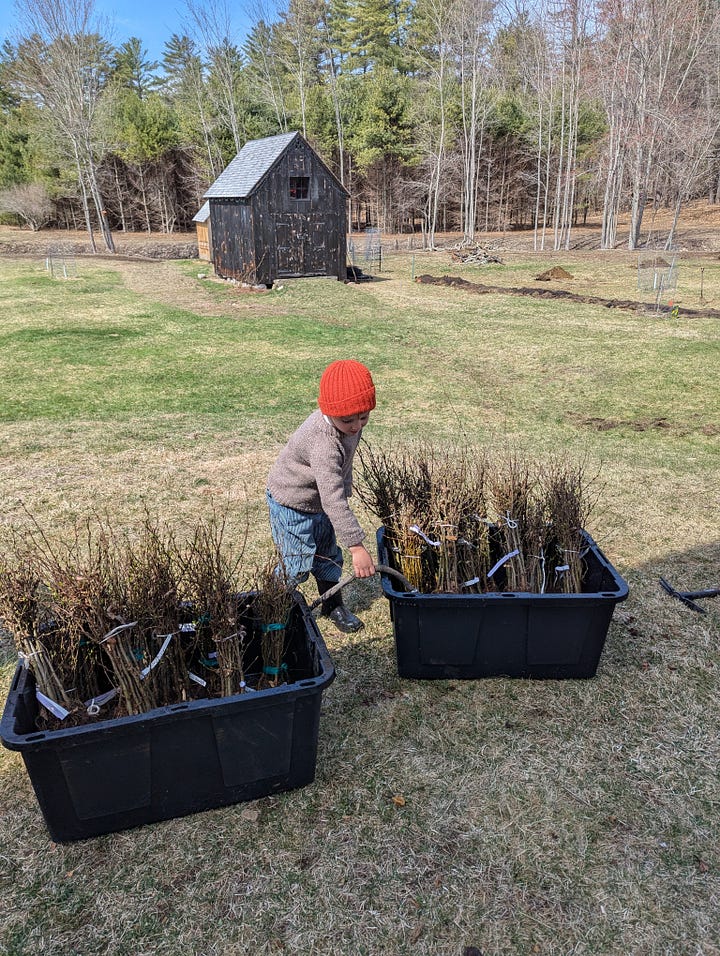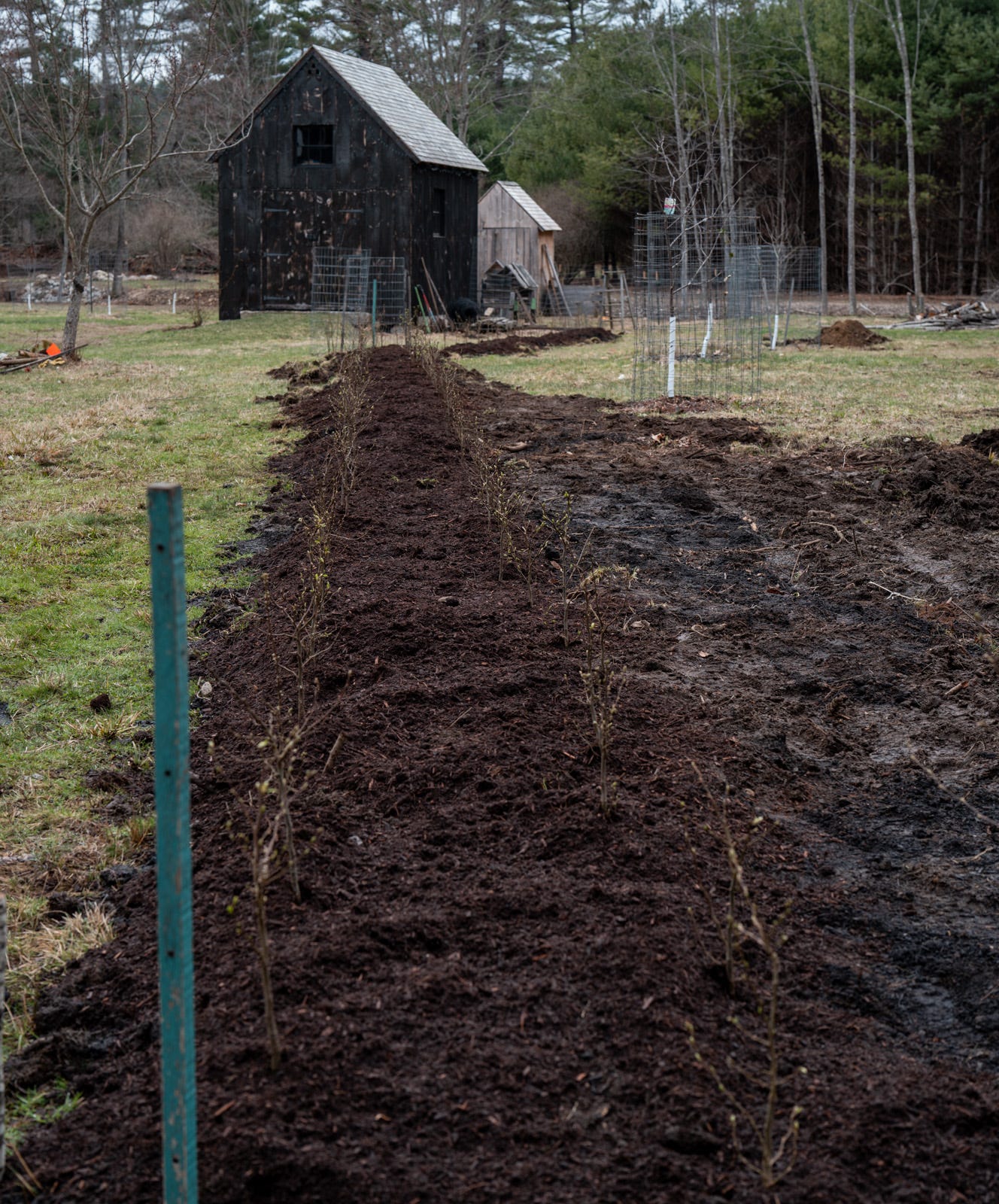While looking over some garden inspiration at the end of March, it came to me that this might be a good year to enclose the orchard. I adore all kinds of hedges and garden walls: open space is very good, but rooms, even nooks, outdoor places with structure and privacy, these are even better.
Stone or brick walls are out of the question, but I wondered if it might be possible to make a hornbeam hedge that partly encloses the orchard, in an L-shape, with the stream and the forest on the other boundaries. Hedges were one of our first hopeful ideas when we bought the land, but (like a lot of hopeful outdoor plans) they were soon dropped as we realized the scope of outdoor work that needed to come first.




American and European (carpinus betulus) hornbeam are both a very dense wood with a nice habit, though European is preferred for hedges. They are unfussy about soil acidity, don’t mind moisture, and can tolerate shade fairly well, all three of which are necessary for this particular spot. Hornbeam grows slowly, which is somewhat a downside, but it also means the hedge maintenance won’t overwhelm me. The time will pass anyways.
As I began researching where to buy, I was dismayed to find that many wholesalers of hornbeam were sold out of some larger hedging specimens for the year. The reason for this is that many wholesalers ship their final shipment the first week of April (this is around when many retail nurseries in New Hampshire might open for the year). Other ones had huge specimens (6-7 feet tall) for $280 each, but this would mean I could only buy a few, and trucking costs would further infringe on the budget.
But I did find one nursery in Oregon that had listed 3/8” caliper (trunk measurement) hornbeam for just $3.20 each. One minor problem is that their regular season was over, they would make a shipment in early April, but without warranty. Another problem is that the minimum order is $750, which meant I would need to buy at least 240 tree saplings. This is much more than I needed or thought I could reasonably plant. And lastly they were likely to be quite small, maybe just a foot high, so it would take 5-10 years before it looks like a real hedge.
Still, if I didn’t order 240 saplings, I would forfeit my chance to get something in the ground this year. Because of the slow growth, I want as many years in the ground as possible, and the uncertain possibility of buying larger specimens next year also comes with a correspondingly larger cost. So why not try? I ordered the 240, and called a friend with a tractor to ask for some help with land prep.
My plan was simple: the tractor can rough up the L-shape, approximately 240 feet, by turning over the grass (picking it up and putting it back down). I would order 7 yards of compost, and he would lay this on top of the line. At the same time he could use a little dirt from the far field to raise a low spot by a few inches. Finally I would top-dress the planting area with 6 yards of mulch.
My plan was also untested. I assumed that by breaking the sod layer and putting down a lot of compost, it would be easy enough to stick in 240 saplings without a lot of shovel or pickaxe work for each one. I am also (present day) assuming the compost and mulch will keep them protected, to need only a little watering, and that planting directly into this compost wouldn’t burn the roots. I’ve bought compost from this local place before so I am reasonably sure it would be aged enough.

I had to do a lot of raking and some shoveling to clean up the rough tractor work, which took about five hours of labor. Then the day the hornbeam arrived, I unboxed them and soaked them in bins — they were in transit for three days and just coming out of dormancy, so this is the expected thing to do for bare root plants. After a minimum 30 minutes in the tub, I got to work.




They are spaced 2 feet apart, with a second staggered row stacked behind. This seemed like the most reasonable way to use the large number I had to work with. So effectively there is one hornbeam per foot. I probably should have spaced the two rows wider apart, but because I was planting within where the tractor did most of the work, they might be tighter than the ideal.
The work took about six or seven hours, planting and mulching, with some mulching left for day two. Some areas of the line were quick, but others required more work to ensure a prepared seedling site. But it was a reasonable amount for one person to plant in one day on prepped land. As always, now that I’ve done it, I would be faster the next time.1
Completed, it looks like very little except up close:
The specimens are good and I’m very happy with the wholesaler, Heritage Seedlings. Only a single one had damage.
Cost breakdown
240 Hornbeam — $768
UPS 3-day shipping — $260
7 yards of compost — $334
6 yards of mulch (it turned out I needed less mulch) — $285
Hiring friend with tractor — Approximately $500, I had him do some other work (moving brush and small pine trees) while here, so its hard to be precise with this cost.
So the hedge cost approximately $2,147. If I bought the 6-to-7 foot hornbeams, I would have only been able to buy ~8 plants for the same price.
~ ~ ~
I ended up using 224 saplings for the length of the hedge, ending by the forest in a pentagon shape, and giving some room for an opening in each line. With the remaining saplings I planted a circle on the other side of the field.

It might (eventually) make an interesting shape for children to hide inside of, or else a kind of sculpture for a rose or two to ramble through. But more likely if there are any problem seedlings on my hedge, I will be taking from here to replenish the line.
The final four saplings I planted farther away from the house, in a spot that I might forget about. Maybe I’ll rediscover them midsummer, or years later, when they start to grow and give more color.
~ ~ ~
see also: The Goose Palace, Everything I know about gardening, Why make something beautiful?
this is good practice because I have also ordered 125 saplings from the New Hampshire state nursery (the state makes this very inexpensive), 25 each of American hazelnut, white spruce, red spruce, balsam fir, and button bush.





Second idea: hornbeam comes into leaf in the Middle of autumn. We planted daffodils at the roots of the trees. They are flowering before the hedge turns green. When the daffodils have expended their flowers, the remaining green leafs Will be hidden by the new foliage.
Picturing a manicured English garden in a generation or two.